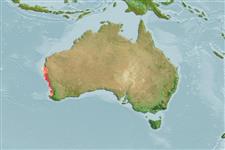分類 / Names
俗名 | 同種異名 | Catalog of Fishes(屬, 種) | ITIS | CoL | WoRMS | Cloffa
Environment: milieu / climate zone / depth range / distribution range
生態學
海洋 礁區魚類; 深度上下限 6 - 15 m (Ref. 57886). 溫帶; 25°S - 34°S (Ref. 57886)
Eastern Indian Ocean: Western Australia.
東印度洋: 澳洲西部。
大小 / 重量 / 年齡
Maturity: Lm ? range ? - ? cm
Max length : 19.7 cm SL 雄魚/尚未辨別雌雄; (Ref. 57886); 16.2 cm SL (female)
簡短描述
型態特徵 | 形態測量圖
背的軟條 (總數): 161-191; 臀鰭軟條: 109 - 124; 脊椎骨: 79 - 87. The species is distinguished in having a very elongate, almost eel-like body; vertebrae 22-25 + 57-65 = 79-87, dorsal fin rays 161-191, anal fin rays 109-124, D/A 58-75, V/A 27-28; no scales; no supraorbital pore behind eye; lower preopercular pores 2; posterior infraorbital pores 3; broad angle on ventral maxilla positioned behind rear of eye; exposed opercular spine small, short, straight; lower lip with prominent skin folds; single pair of pseudoclaspers curved outwards, with narrow base and pointed tip, with broadly expanded fleshy flaps anteriorly and posteriorly; penis small, less than half the length of pseudoclaspers, with hook at tip; otoliths
pointed anteriorly, rounded posteriorly, predorsal angle more pronounced than postdorsal angle (Ref. 57886).
此魚種被差別在於有一個非常長又幾乎像鰻魚一樣的身體; 脊椎骨 22-25+57-65=79-87 ,背鰭鰭條 161-191 ,臀鰭棘條 109-124, D/一 58-75, V/一 27-28; 沒有鱗片; 沒有在眼後面的眶上孔; 低的前鰓蓋骨孔 2; 在後部的眶下孔 3; 在腹的顎骨上的寬的角放置了眼在後後面; 暴露出來鰓蓋棘小的﹐短的, 直線; 下唇有突出的皮膚摺層; 單一成對的 pseudoclaspers 向外地彎曲,有狹窄的基底與尖的頂端, 具有前面地而且在後部地變得很寬肉質的鰓蓋; 陽物小的, 少於一半的 pseudoclaspers 的長度, 藉由鉤在頂端; 耳石
朝向前面, 在後部地圓的, 前背的角比後背的角更多的明顯角.(參考文獻 57886)
Uncommon species inhabiting shallow reefs (Ref. 34024). A benthic species (Ref. 75154).
稀有的種居住於淺水礁區.(參考文獻 34024)
Life cycle and mating behavior
成熟度 | 繁殖 | 產卵場 | 卵 | 孕卵數 | 仔魚
東印度洋: 澳洲西部。
Møller, P.R. and W. Schwarzhans, 2006. Review of the Dinematichthyini (Teleostei, Bythitidae) of the Indo-west Pacific, Part II. Dermatopsis, Dermatopsoides and Dipulus with description of six new species. The Beagle 22:39-76. (Ref. 57886)
人類使用
漁業: 沒有興趣
更多資訊
俗名同種異名新陳代謝捕食者生態毒物學繁殖成熟度產卵場產卵群集孕卵數卵卵發育
年龄/大小成長長度-重量長度-長度長度-頻率形態測量圖型態特徵仔魚稚魚動力學入添量豐度BRUVS
參考文獻養殖養殖資訊品種遺傳學Electrophoreses遺傳率疾病加工NutrientsMass conversion
合作者照片Stamps, Coins Misc.聲音神經毒速度泳型鰓區Otoliths腦重體重比眼睛色素
工具
特別的報告
下載 XML
網路資源
Estimates based on models
Preferred temperature (Ref.
123201): 18 - 23.8, mean 20.1 °C (based on 76 cells).
Phylogenetic diversity index (Ref.
82804): PD
50 = 0.6250 [Uniqueness, from 0.5 = low to 2.0 = high].
Bayesian length-weight: a=0.00389 (0.00180 - 0.00842), b=3.12 (2.94 - 3.30), in cm total length, based on all LWR estimates for this body shape (Ref.
93245).
營養階層 (Ref.
69278): 3.5 ±0.6 se; based on size and trophs of closest relatives
Fishing Vulnerability (Ref.
59153): Low vulnerability (14 of 100).
